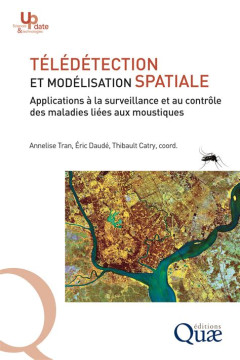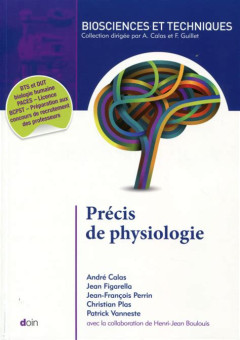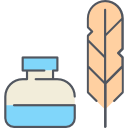Filter by

Comment les énergies fossiles détruisent notre santé, le climat et la biod…
Les énergies fossiles et leurs émissions de gaz à effet de serre ne sont pas seulement la cause directe du réchauffement climatique. Elles sont aussi à l’origine de deux autres menaces majeures pour l’humanité : la pollution chimique et la perte de biodiversité, qui affectent à la fois notre santé et notre environnement. Internationalement reconnue pour ses travaux sur les perturb…
- الإصدارة
- -
- ردمك/ردمد
- 978-2-4150-0081-3
- التوريق
- 296p.
- عنوان السلسلة
- -
- رقم الطلب
- 615-4/005

UE6, Initiation à la connaissance du médicament: toute la paces en QCM
Conçus et développés par les meilleurs spécialistes de la PACES, ces ouvrages donnent toutes les chances de réussir au concours. Avec plusieurs centaines de QCM tirés de sujets officiels et couvrant tout le programme, les livres de la collection Toute la PACES en QCM permettent de s’entraîner et de s’évaluer pour être prêt le jour J !
- الإصدارة
- -
- ردمك/ردمد
- 9782340-022713
- التوريق
- 101p.
- عنوان السلسلة
- -
- رقم الطلب
- 615-4/004

Plantes sauvages médicinales: les 50 plantes essentielles et leurs usages
Reconnaître sans erreur et utiliser les 50 plantes sauvages médicinales les plus intéressantes Grâce à ce livre, on peut, sans connaissances préalables, reconnaître avec certitude les 50 plantes sauvages médicinales communes les plus intéressantes pour la pharmacie familiale. Chaque partie de la plante importante pour sa reconnaissance (forme des feuilles, spécificité de la fleur,…
- الإصدارة
- -
- ردمك/ردمد
- 978-2-37922-047-0
- التوريق
- 271p.
- عنوان السلسلة
- -
- رقم الطلب
- 615-4/003

Plantes aromatiques: comment les cultiver et les entretenir facilement
Toutes les nouvelles connaissances sur le monde des plantes aromatiques. Le guide indispensable à la fois pour débuter leur culture et pour tous ceux qui les apprécient déjà. Traditionnellement présentes dans les jardins, on cultive aujourd'hui les plantes aromatiques partout, en pots sur une terrasse, un rebord de fenêtre ou dans sa cuisine. Indispensables en cuisine et en médecine do…
- الإصدارة
- -
- ردمك/ردمد
- 978-2-37922-151-4
- التوريق
- 127p.
- عنوان السلسلة
- -
- رقم الطلب
- 615-4/002

La santé par les abeilles: bienfaits et limites de l'apithérapie
Les bienfaits avérés des produits de la ruche. Un livre qui démêle le vrai du faux et aide à faire des choix avisés. Miel, gelée royale, pollen, propolis, etc., les produits de la ruche, qui séduisent pour leurs qualités diététiques, médicinales et gustatives, sont désormais en vente partout. Leur composition, riche en antioxydants et en antimicrobiens, explique leur utilisation …
- الإصدارة
- -
- ردمك/ردمد
- 978-2-37922-102-6
- التوريق
- 141p.
- عنوان السلسلة
- -
- رقم الطلب
- 615-4/001

Télédétection et modélisation spatiale: applications à la surveillance e…
Les moustiques sont vecteurs de nombreux agents pathogènes responsables de maladies, telles que le paludisme, la dengue, le chikungunya ou la fièvre jaune. Selon l’Organisation mondiale de la santé, ils provoquent plusieurs centaines de milliers de décès chaque année. Ils sont aussi à l’origine de zoonoses, comme la fièvre de la vallée du Rift et la fièvre du Nil occidental. Da…
- الإصدارة
- -
- ردمك/ردمد
- 978-2-7592-3628-2
- التوريق
- 147p.
- عنوان السلسلة
- -
- رقم الطلب
- 614-4/001

Précis de physiologie
Le Précis décrit de façon didactique et illustrée les principes fondamentaux de la physiologie. Il propose en outre, à la lumière des progrès scientifiques récents, des approfondissements sur des thèmes en évolution ou réputés plus difficiles : endocrinologie, système immunitaire, circulation, neurotransmission, physiologie du coït, etc. Il s'adresse aux étudiants de premier c…
- الإصدارة
- -
- ردمك/ردمد
- 978-2-7040-1420-0
- التوريق
- 379p.
- عنوان السلسلة
- -
- رقم الطلب
- 612-4/003

Manuel d'anatomie et de physiologie humaines
LA référence pour les étudiants en IFSI afin de maîtriser tous les concepts en anatomie et physiologie humaines du programme. Tous les principaux concepts nécessaires à la compréhension du fonctionnement du corps humain sont traités dans ce manuel. Grâce à la qualité de son texte et de ses 2000 illustrations, il vous permettra d’acquérir de solides connaissances de base en anatom…
- الإصدارة
- -
- ردمك/ردمد
- 978-2-8073-2705-4
- التوريق
- 723p.
- عنوان السلسلة
- -
- رقم الطلب
- 612-4/002

Introduction à la circulation des fluides physiologiques: cours et exercices…
La collection PASS - Licence santé propose des outils indispensables pour évaluer ses connaissances et son degré de compréhension des cours pour toutes les nouvelles matières de la PASS et de la LAS : Préparer les épreuves du nouveau concours ; Réviser régulièrement les notions fondamentales du cours et évaluer ses connaissances ; Compléter et améliorer ses révisions grâce �…
- الإصدارة
- -
- ردمك/ردمد
- 9782340-058118
- التوريق
- 322p.
- عنوان السلسلة
- -
- رقم الطلب
- 612-4/001

QCM illustrés d'anatomie: anatomie générale, tête et cou, petit bassin, UE5
Cet ouvrage contient des QCM du nouveau programme de la PAES en anatomie. Toutes les variétés de QCM sont présentées afin de permettre un entraînement complet. La première partie concerne l'anatomie générale (UE5), la deuxième partie contient des QCM sur la tête et le cou, la troisième partie est relative au petit bassin de la femme. De difficulté variable, ces QCM de type co…
- الإصدارة
- -
- ردمك/ردمد
- 978-2-7298-6347-0
- التوريق
- 213p.
- عنوان السلسلة
- -
- رقم الطلب
- 611-4/003
 Computer Science, Information & General Works
Computer Science, Information & General Works  Philosophy & Psychology
Philosophy & Psychology  Religion
Religion  Social Sciences
Social Sciences  اللغة
اللغة  Pure Science
Pure Science  Applied Sciences
Applied Sciences  Art & Recreation
Art & Recreation  Literature
Literature  History & Geography
History & Geography